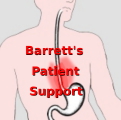Research
We hope that this section of our website will give you a summary of the research that is being carried out, and how this may affect outcomes in due course.
Early Diagnosis
Cytosponge:
Professor Rebecca Fitzgerald at Cambridge and her team are working on Cytosponge, a ‘pill on a string’ that would enable nurses in GP surgeries to collect samples that would be analysed to diagnose Barrett’s Oesophagus, a precursor to oesophageal adenocarcinoma (sensitivity 79.9%, specificity 92.4% in BEST2 trial). In 2020 the BEST3 trial concluded and BEST4 will monitor long term effects on reducing mortality. Barrett's Oesophagus is identified by reference to the TFF3 protein. Cytosponge might be introduced to standard clinical practice, subject to passing NICE Guidance process. The NG231 Guidance Committee, reported in Gut journal in 2023-24 considered that there was a high diagnostic accuracy with biomarkers for dysplasia and cancer but that the sensitivity was not high enough for normal clinical practice. The Cyted laboratory is developing machine learning / artificial intelligence to identify dysplasia, signs of squamous cell carcinoma and perhaps other conditions in due course. In 2023 the laboratory had dealt with more than 10,000 samples.
Breath test:
Being developed by Professor George Hanna at Imperial College, a breath test would identify cells relative to oesophageal adenocarcinoma using volatile organic compounds. It is known that some dogs can smell cancer, and this project could potentially identify other cancers.
https://www.imperial.nhs.uk/about-us/blog/new-breath-test-tackles-oesophageal-cancer
More recently, the breath test also being looked at by Professor Rebecca Fitzgerald
https://www.medicalnewstoday.com/articles/324099.php
A Dutch study by Yonne Peters, Peter D Siersema and colleagues have used an Aenose device as a Barrett's Oesophagus prediction model (sensitivity 91%, specificity 74%) using volatile organic compounds.
https://gut.bmj.com/content/early/2020/01/07/gutjnl-2019-320273
Saliva test:
Professor Laurence Lovat at University College Hospital, London, is conducting the SPIT study, examining saliva tests.
https://gutscharity.org.uk/research/current-active-research/professor-laurence-lovat/
When combined with a questionnaire related to cancer risks, the saliva test can apparently predict cancer to a very significant level.
Blood test:
On 27 November 2020 it was announced that the NHS would be undertaking a trial of the Galleri blood test developed by Grail that may potentially identify signs of more than 50 types of cancer based on molecular changes. It is not clear how effective this test might be in identifying oesophageal adenocarcinoma or oesophageal squamous cell carcinoma, but the trial is reported to aim to include 140,000 people aged 50-79 who will have blood tests for three years who have no symptoms, and a further 25,000 with possible cancer-related symptoms.
Cancer tumours shed traces of DNA into the blood, which the Galleri test can detect. Later stage tumours will shed more DNA than early stage tumours so it is not clear how effective the test will be in detecting tumours at early stages when treatment will be more likely to be successful.
On the issue of whether the test would detect both adenocarcinoma and squamous cell carcinoma, Grail have provided the following information:
'How the Galleri Test Works
Galleri does not detect specific cancer types. Galleri detects a shared cancer signal based on cell-free DNA methylation
patterns and then uses methylation pattern information to localize the cancer signal to a tissue or organ. Because Galleri does not detect specific cancers types, the only cancer type
information available is after diagnostic evaluation determines the cancer type and stage.
Galleri is a targeted methylation, next-generation sequencing (NGS)-based assay analyzing cell-free DNA (cfDNA) isolated from peripheral blood. All cells, including cancer cells, release DNA
fragments that can be found in the circulatory system. cfDNA from cancer cells have specific methylation patterns that identify it as cancer. DNA methylation is a natural process used by cells to
regulate gene expression. The test leverages inherent biological information, specifically that methylation drives tissue differentiation and can contribute to cancer generation.
The Galleri test is a single test that detects a cancer signal shared across multiple cancer types; it is not a composite of multiple individual cancer detection tests. The classifier has been
trained using thousands of cancer samples across a vast diversity of cancer biology in addition to non-cancer samples. Cancer signal detection is the result of machine learning algorithms based on
biological information from the samples experienced by the classifier.
The assay interrogates genomic regions, which include methylation targets that have demonstrated the ability to discriminate between individuals with cancer and individuals without cancer. The
targeted methylation panel covers over 100,000 distinct regions (17.2 Mb) and over a million cytosine-guanine dinucleotides (CpGs). The Galleri test is designed to capture and aggregate observations
across abnormally methylated fragments which may be leveraged to generate accurate predictions regarding the presence or absence of a cancer signal.
For a “Cancer Signal Detected” test result, genomic regions are examined to enable the secondary feature of predicting tissue type or organ of cancer signal origin. The Galleri test examines features
extracted from methylation data and pattern recognition to provide biological and/or anatomic information that can help localize the cancer. The Galleri test report predicts the top 1 or 2 Cancer
Signal Origins (CSOs). The CSO prediction offers information about the tissue type or organ associated with the Cancer Signal. The CSO labels are designed to help the provider determine next steps
for diagnostic evaluation.'
UK Barrett's Oesophagus Registry
This registry once contained data on around 14,500 patients registered by gastroenterologists at 48 centres, and was the largest registry in the world for this condition. Sadly, the registry has been obliged to close (as in 2021) because of lack of support.
The objective of the Registry was to identify groups of Barrett’s (BO) patients who are most likely to progress towards oesophageal adenocarcinoma (OAC). They have considered several different groups but identified men with Barrett’s who were blood group rhesus negative as being three times more likely than other groups to progress to cancer. There was a logical connection because of the distribution of nitric oxide, but more studies are needed to replicate the research. Other bodies may not have recorded blood groups. They are a very small group but a perfect example of a BO group at greater risk of OAC.
BO was being diagnosed at a younger age, possibly due to greater awareness by GPs.
A study using the government’s index of multi-deprivation from postcodes using an index from 1 to 6 where 6 was the most deprived. The second least deprived segment was most likely to get BO. In a separate study using occupation to get social class it was the Skilled Manual workers social class IIIM who were most at risk, possibly due to heavy and repetitive lifting and bending.
Mortality among people with Barrett’s was found to be greater than that of the general population, but only because of the effect of OAC oesophageal cancer. 20x as much mortality was being caused amongst the Barrett’s population from OAC. However, this had not been confirmed by all papers.
The Registry was unique; the most similar in the UK was one set up in Northern Ireland by the late Liam Murray, but it had not included blood groups.
In the US there has been a tendency to diagnose patients as having BO only when they had Intestinal Metaplasia (IM). UKBOR's research showed there was no statistical difference on progression to OAC between those with Barrett’s and IM and those just with Barrett’s at diagnosis.
Segmentation was well covered by the database, with 3cm being the criterion qualifying it as short segment. The shorter segments could give significant risk, but generally the longer the segment the higher the risk.
The biggest problem for the Registry was patient consent making it difficult to get data. Whereas patient consent for cancer research has been on an 'opt in' basis, for pecursor conditions it is more difficult and expensive to achieve informed consent with limited clinic time.
Adobe Acrobat document [69.1 KB]
Adobe Acrobat document [188.6 KB]
Oelixir & OCCAMS
The Oelixir project comprises a number of cancer treatment centres collaborating to improve the biological understanding of oesphageal adenocarcinoma. After a series of negative Phase 2/3 trials, there is now more concentration on gaining genomic insights and using precision biology to explain why some oncological therapies worked and others did not for some patients. 23 OCCAMS centres are collaborating together. The projects within Oelixir are PREDICT, PROPER, RISE, CITADEL, ELEVATE and RISE.
"The OCCAMS (Oesophageal Cancer Clinical and Molecular Stratification) study is a network of clinical centres recruiting OAC patients for tissue collection. OAC patient data and tissue samples are used to attempt to identify clinical, demographic and molecular factors affecting disease progression"
https://www.mrc-cu.cam.ac.uk/research/rebecca-fitzgerald/clinical-studies/occams
The Cancer Research UK website contains more details about research projects.
RHBDF2 mutations in Tylosis OSCC
In February 2020 it was reported that the RHBDF2 gene mutation found in a small number of people who suffer from tylosis, an inherited skin condition with an association with squamous cell oesophageal adenocarcinoma (OSCC), may have implications for other sufferers of OSCC. This work is carried out by Professor David P Kelsell of Queen Mary College London and colleagues.
https://www.fiercebiotech.com/biotech/high-risk-oesophageal-cancer-gene-discovered





















